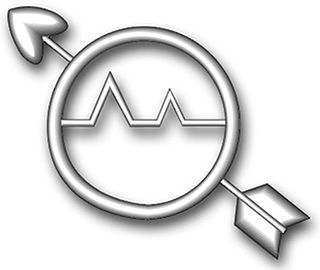Related Research Articles
The United States Armed Forces are the military forces of the United States. The armed forces consist of six service branches: the Army, Marine Corps, Navy, Air Force, Space Force, and Coast Guard. All six armed services are among the eight uniformed services of the United States.

The Defense Information Systems Agency (DISA), known as the Defense Communications Agency (DCA) until 1991, is a United States Department of Defense (DoD) combat support agency composed of military, federal civilians, and contractors. DISA provides information technology (IT) and communications support to the President, Vice President, Secretary of Defense, the military services, the combatant commands, and any individual or system contributing to the defense of the United States.

The Portuguese Armed Forces are the military of Portugal. They include the General Staff of the Armed Forces, the other unified bodies and the three service branches: Portuguese Navy, Portuguese Army and Portuguese Air Force.
A United States military occupation code, or a military occupational specialty code, is a nine-character code used in the United States Army and United States Marine Corps to identify a specific job. In the United States Air Force, a system of Air Force Specialty Codes (AFSC) is used. In the United States Navy, a system of naval ratings and designators are used along with the Navy Enlisted Classification (NEC) system. A system of ratings is also used in the United States Coast Guard.
The Air Force Specialty Code (AFSC) is an alphanumeric code used by the United States Air Force to identify a specific job. Officer AFSCs consist of four characters and enlisted AFSCs consist of five characters. A letter prefix or suffix may be used with an AFSC when more specific identification of position requirements and individual qualifications is necessary. The AFSC is similar to the Military Occupational Specialty Codes used by the United States Army and the United States Marine Corps or enlisted ratings and USN officer designators and Naval Officer Billet Classifications (NOBCs) used by the United States Navy and enlisted ratings and USCG officer specialties used by the United States Coast Guard. The United States Space Force equivalent is known as the Space Force Specialty Code (SFSC).

The United States Army Signal Corps (USASC) is a branch of the United States Army that creates and manages communications and information systems for the command and control of combined arms forces. It was established in 1860, the brainchild of Major Albert J. Myer, and had an important role in the American Civil War. Over its history, it had the initial responsibility for portfolios and new technologies that were eventually transferred to other U.S. government entities. Such responsibilities included military intelligence, weather forecasting, and aviation.
A systems integrator is a person or company that specializes in bringing together component subsystems into a whole and ensuring that those subsystems function together, a practice known as system integration. They also solve problems of automation. Systems integrators may work in many fields but the term is generally used in the information technology (IT) field such as computer networking, the defense industry, the mass media, enterprise application integration, business process management or manual computer programming. Data quality issues are an important part of the work of systems integrators.

Cryptologic technician (CT) is a United States Navy enlisted rating or job specialty. The CT community performs a wide range of tasks in support of the national intelligence-gathering effort, with an emphasis on cryptology and signal intelligence related products.

Cavalry Scout is the job title of someone who has achieved the military occupational specialty of 19D Armored Reconnaissance Specialist in the Combat Arms branch of the United States Army. As with all enlisted soldiers in the United States Cavalry, the person holding the Scout specialization will still be referred to as a "Trooper", the traditional colloquialism denoted in the cavalry's Order of the Spur.

In the United States Armed Forces, the ranks of warrant officer are rated as officers above all non-commissioned officers, candidates, cadets, and midshipmen, but subordinate to the lowest officer grade of O‑1. This application differs from the Commonwealth of Nations and other militaries, where warrant officers are the most senior of the other ranks, equivalent to the U.S. Armed Forces grades of E‑8 and E‑9.

A religious affairs specialist, previously known as chaplain assistant, is a member of the U.S. Army Chaplain Corps. This soldier provides expertise in religious support and religious support operations. The Religious Affairs Specialists, which is military occupational specialty (MOS) 56M, support the unit Chaplain and Commander in responding to the needs of soldiers, family members, and other authorized personnel. They provide security to Army chaplains. Duties include preparing spaces for worship, managing supplies, and ensuring the security and safety of the chaplain during combat situations.

Operations Specialist is a United States Navy and United States Coast Guard occupational rating. It is a sea duty-intensive rating in the Navy while most of Coast Guard OS's are at ashore Command Centers.
LandWarNet (LWN) is the United States Army’s contribution to the Global Information Grid (GIG) that consists of all globally interconnected, end-to-end set of Army information capabilities, associated processes, and personnel for collecting, processing, storing, disseminating, and managing information on demand supporting warfighters, policy makers, and support personnel. It includes all Army and leveraged Department of Defense (DOD)/Joint communications and computing systems and services, software, data security services, and other associated services. LandWarNet exists to enable the warfighter through Mission Command, previously described as Battle Command. Other U.S. service equivalent efforts to LandWarNet include the Navy's "FORCEnet" and the Air Force's "C2 Constellation."

Marine Corps Communication-Electronics School (MCCES) is the Marine Corps training ground for the majority of the communications and air/ground electronic maintenance Military Occupational Specialties (MOS). MCCES is based at the Marine Corps Air Ground Combat Center Twentynine Palms, California.

Information systems technician (IT) is a rating for United States Navy and United States Coast Guard enlisted personnel, specializing in communications technology. Information systems technician submarines (ITS) is a rating for U.S. Navy submariners. The Information systems technician (IT) rating corresponds to the new Navy Occupational Specialty (NOS) code B460 while the information systems technician submarines (ITS) rating corresponds to Navy Occupational Specialty (NOS) code C260.

The United States Navy job rating of electronics technician (ET) is a designation given by the Bureau of Naval Personnel (BUPERS) to enlisted members who satisfactorily complete initial Electronics Technician "A" school training.
References
- ↑ United States Army's Warrant Officer Recruiting Information Site. . Retrieved on June 4, 2012.